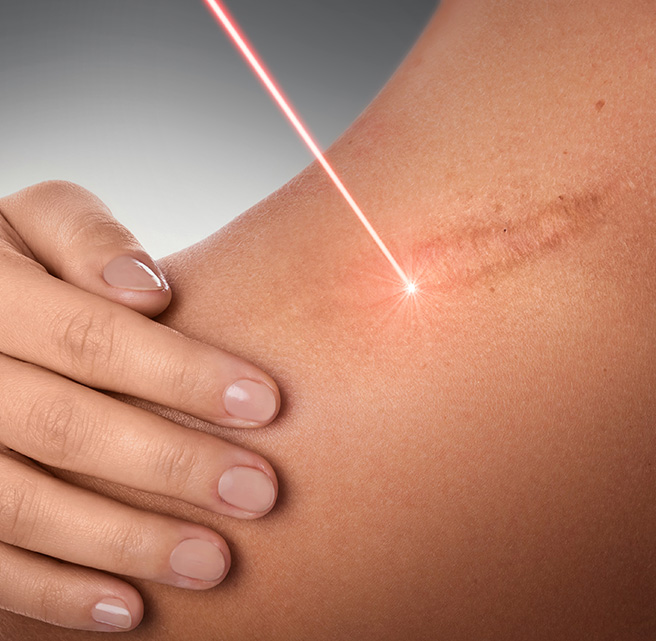Are you curious about laser treatment for keloid scars? Then you have landed on the correct page. In this article, we offer you a deep understanding of keloid scars, their causes, symptoms, and how to remove keloids with a laser.

Keloid Scars
We all have witnessed how our skin repairs after a minor burn or injury. Usually, when there is a minor burn or injury a thin, smooth crust forms over the damaged layer of skin before falling off to reveal a pinkish layer, which is the scar. These scars may vanish, on their own over time, but sometimes, your skin can overreact to the damage with an overgrowth of scar tissue that rarely goes away on its own, and this overgrown scar is known as keloids.
Understanding Keloid Scar
A keloid is a firm, rubbery nodule in an area of prior injury to the skin. In contrast to normal or hypertrophic scars, keloid tissue extends beyond the initial trauma. Patients may complain of an itchy, painful keloid. When skin gets injured, such as from a cut, burn, surgery, or acne, the body’s healing process kicks in, and collagen, a protein starts forming to repair the wound.
Causes for Keloid Scars
When our body produces too much collagen extending beyond the original area, the excess collage creates a raised, thickened scar that may be larger than the original wound. Unlike normal scars, keloids don’t stop growing and may continue to enlarge over time. Genetics, skin type, and other factors may also influence the likelihood of keloid formation. There is a familial tendency for keloid formation, especially in people with highly pigmented skin. This condition is notably more prevalent among individuals of African background keloid.
Symptoms of Keloid Scars
Keloids can be itchy, tender, or even painful, causing discomfort to the affected person. The raised, thickened skin is not only unattractive but can also interfere with normal skin function.
Treatments for keloid Scars
Various treatments can help manage keloids, including:
- Steroid injections: Helps reduce inflammation and flatten the keloid.
- Silicone sheets: Used to flatten and soften the scar tissue.
- Cryotherapy: Freezes the keloid to reduce its size.
- Laser therapy: Targets the keloid tissue to minimize its appearance.
- Excision of keloid scar: Surgically removing the keloid and using a closure technique keloid to minimize recurrence.
Keloid Scars Laser Treatment

Large keloid scars can be flattened by laser treatment. The laser focuses on making the scars shrink and become less noticeable. Keloid scars often look angry and red, but laser treatment helps them calm down and makes the scar less visible. As we have seen above, collagen is like the building blocks that repair our skin, but when your skin produces excess collagen, it causes the scar to grow.
Laser treatment targets the extra collagen to help break it down and make the keloid scar thinner so that it gets better and smoother. Laser enhances the treatment of thick raised sacs by shutting down the blood supply that fuels the scarring process and stimulates the production of new, healthy collagen fibers, promoting healing and helping to flatten the scar. This means it encourages your skin to grow back normally, making the scar less noticeable.
5 Types of Lasers for Keloid Scars Removal
Depending upon the size and severity of the keloid, there are five main types of laser treatments commonly used for keloid scars:
- Pulsed Dye Laser (PDL)
- Fractional Laser Therapy
- Carbon Dioxide (CO2) Laser
- NdLaser
- Excimer Laser
How to Remove Keloid Scars with a Laser
According to the keloid Plastic Surgery Center website laser treatment “uses light beams to target keloid tissue, reducing its size and appearance”. The light beams emitted from the laser penetrate the skin and target the abnormal collagen fibers within the keloid, resulting in the breakdown of excess collagen in the keloid causing it to shrink in size
Benefits of Laser Treatment for Keloid Scars Removal:
lasers are becoming a dermatologist’s go-to treatment for many scars due to the following reasons:
1. The laser targets precise areas, minimizing damage to surroundings.
2. Laser treatment often results in better outcomes.
3. Laser therapy helps maintain collagen production, resulting in controlled healing.
4. It involves minimal downtime, giving the patient the benefit of resuming normal activities much sooner.
5. It offers a personalized approach to treatment depending upon the size and severity of scars.
6. Last but not least, laser therapy Improves skin texture and color, making scars look more natural.
Considerations:
According to the American Academy of Dermatology Association website, Laser treatment can make the scar less noticeable, but it’s still there. A medical consultation is crucial before any laser treatment because everyone is unique and so is their skin type, characteristics of scars, and overall health.
Laser treatment can make scars less noticeable but cannot completely remove them. A medical consultation is crucial to tailor the treatment to your skin type and health. Remember to apply sun protection before and after treatment. Your dermatologist may also suggest a few changes in your lifestyle before treatment. Sometimes your dermatologist may schedule a series of laser treatments to give a patient long-lasting results and improvement. Be patient because results can take months to become visible, requiring patience.
Conclusion:
Laser treatment is a go-to solution suggested by many skin experts for keloid treatment, but it cannot make them completely invisible. Compared to other treatments it is a much better option. Consult your dermatologist or medical expert before making any decision.
Related Article